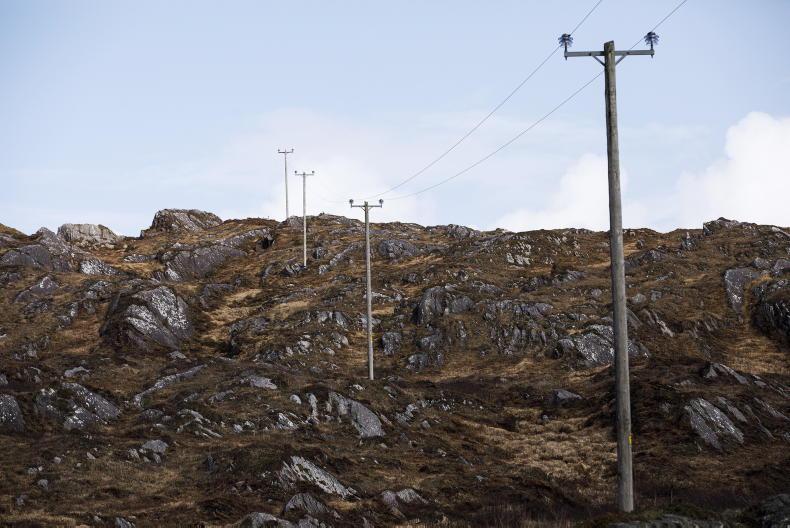“I have recently received correspondence that my land was the preferred route for a 38kV power line. It runs right through the centre of my farm and I want it stopped, or at least the route altered. They also issued a survey notice to say that they are coming to survey the land and I am concerned that they will be bringing in heavy equipment, carrying heavy poles and digging up the land. What are my rights?”
The Electricity Supply Board (ESB) has powers to place any electric line above or below ground, and across any land under section 53 of the Electricity (Supply) Act 1927.
However, before placing an electric line across any land, the ESB must serve notice in writing to the owner and occupier of the land stating its intention to place the line and give a description of the nature of the line or fixture, the position and how it is to be placed.
The right is acquired immediately on service of the notice and can be exercised seven days later. The automatic effect of the s53 procedure was emphasised in a sequence of cases in which the ESB (and more recently Eirgrid) sought interlocutory injunctions where entry onto land was denied. There is no express provision of any right to be heard by the landowner or occupier in advance of the making of the decision to acquire the statutory easement.
Briefing from the ESB
The ESB’s code of practice in relation to access to land and/or premises (available on the ESB’s website) provides that, before any construction work commences, a representative from the ESB will discuss the entry routes for construction and as far as possible give the landowner the proposed programme of work and the date of commencement of work.
The code of practice also makes provision for practical aspects of the installation and maintenance of the apparatus such as ensuring restrictions on the use of the land during construction are minimised, due care to minimise land damage by crews and equipment, precautions to prevent straying of livestock, precautions to prevent the spread of animal disease etc.
This supersedes the code of practice negotiated between the ESB and the Irish Farmer’s Assocation (IFA) in 1985 and the ESB now adopts the position that this code is not enforceable as was seen in the 2014 case of Rossmore Properties v ESB, though the code has not been withdrawn.
Written agreement
The code of practice also provides that all lines and all cables of all voltages crossing land which is not a public highway/railway/tramway should be wayleaved. The wayleave is a written agreement between the landowner and the ESB which permits the ESB to install or retain their apparatus on the land.
The wayleave will also include a right for the ESB to access your land going forward to maintain the apparatus as necessary. The wayleave agreement would normally be registered as a burden against your title (folio). This puts people including banks and prospective purchasers of the land on notice of the existence of the wayleave.
Compensation
As regards compensation which may be due, the Electricity (Supply) (Amendment) Act 1985 provides for the entitlement of landowners to be paid compensation in respect of the exercise by the ESB of its powers.
If the ESB erects a power line over your land following the service of a wayleave notice, the owner of the land, and any occupier of the land, are entitled to compensation for all loss and damage arising from the entry onto the land and the placing of the line including compensation for the acquisition of the wayleave for the line.
This applies to all voltages of line and to all types of structures including single wood poles. In practice, for transmission lines of 110kV and upwards, the compensation and the rights of entry are negotiated with Eirgrid in advance of entry and for distribution lines of 38kV and lower the compensation and rights of entry are negotiated with ESB Networks.
The recipient of the notice is entitled to one-off compensation for the initial placing of the line. There is no statutory right to ongoing subsequent compensation for the presence of a line. Where subsequent works to the line are carried out, further compensation maybe claimed. If compensation cannot be agreed, you can have the matter determined by a State-appointed property arbitrator whose decision is binding on both parties under Section 1 of the Acquisition of Land (Assessment of Compensation) Act 1919.
Disclaimer: The information in this article is intended as a general guide only. While every care is taken to ensure accuracy of information contained in this article, Aisling Meehan Agricultural Solicitors does not accept responsibility for errors or omissions howsoever arising.
Read more
Rights of Way – part four: readers’ queries answered
Rights of way part 3: readers’ queries answered
“I have recently received correspondence that my land was the preferred route for a 38kV power line. It runs right through the centre of my farm and I want it stopped, or at least the route altered. They also issued a survey notice to say that they are coming to survey the land and I am concerned that they will be bringing in heavy equipment, carrying heavy poles and digging up the land. What are my rights?”
The Electricity Supply Board (ESB) has powers to place any electric line above or below ground, and across any land under section 53 of the Electricity (Supply) Act 1927.
However, before placing an electric line across any land, the ESB must serve notice in writing to the owner and occupier of the land stating its intention to place the line and give a description of the nature of the line or fixture, the position and how it is to be placed.
The right is acquired immediately on service of the notice and can be exercised seven days later. The automatic effect of the s53 procedure was emphasised in a sequence of cases in which the ESB (and more recently Eirgrid) sought interlocutory injunctions where entry onto land was denied. There is no express provision of any right to be heard by the landowner or occupier in advance of the making of the decision to acquire the statutory easement.
Briefing from the ESB
The ESB’s code of practice in relation to access to land and/or premises (available on the ESB’s website) provides that, before any construction work commences, a representative from the ESB will discuss the entry routes for construction and as far as possible give the landowner the proposed programme of work and the date of commencement of work.
The code of practice also makes provision for practical aspects of the installation and maintenance of the apparatus such as ensuring restrictions on the use of the land during construction are minimised, due care to minimise land damage by crews and equipment, precautions to prevent straying of livestock, precautions to prevent the spread of animal disease etc.
This supersedes the code of practice negotiated between the ESB and the Irish Farmer’s Assocation (IFA) in 1985 and the ESB now adopts the position that this code is not enforceable as was seen in the 2014 case of Rossmore Properties v ESB, though the code has not been withdrawn.
Written agreement
The code of practice also provides that all lines and all cables of all voltages crossing land which is not a public highway/railway/tramway should be wayleaved. The wayleave is a written agreement between the landowner and the ESB which permits the ESB to install or retain their apparatus on the land.
The wayleave will also include a right for the ESB to access your land going forward to maintain the apparatus as necessary. The wayleave agreement would normally be registered as a burden against your title (folio). This puts people including banks and prospective purchasers of the land on notice of the existence of the wayleave.
Compensation
As regards compensation which may be due, the Electricity (Supply) (Amendment) Act 1985 provides for the entitlement of landowners to be paid compensation in respect of the exercise by the ESB of its powers.
If the ESB erects a power line over your land following the service of a wayleave notice, the owner of the land, and any occupier of the land, are entitled to compensation for all loss and damage arising from the entry onto the land and the placing of the line including compensation for the acquisition of the wayleave for the line.
This applies to all voltages of line and to all types of structures including single wood poles. In practice, for transmission lines of 110kV and upwards, the compensation and the rights of entry are negotiated with Eirgrid in advance of entry and for distribution lines of 38kV and lower the compensation and rights of entry are negotiated with ESB Networks.
The recipient of the notice is entitled to one-off compensation for the initial placing of the line. There is no statutory right to ongoing subsequent compensation for the presence of a line. Where subsequent works to the line are carried out, further compensation maybe claimed. If compensation cannot be agreed, you can have the matter determined by a State-appointed property arbitrator whose decision is binding on both parties under Section 1 of the Acquisition of Land (Assessment of Compensation) Act 1919.
Disclaimer: The information in this article is intended as a general guide only. While every care is taken to ensure accuracy of information contained in this article, Aisling Meehan Agricultural Solicitors does not accept responsibility for errors or omissions howsoever arising.
Read more
Rights of Way – part four: readers’ queries answered
Rights of way part 3: readers’ queries answered










SHARING OPTIONS